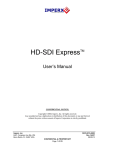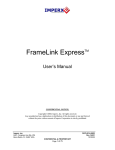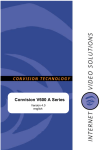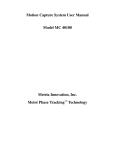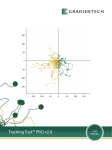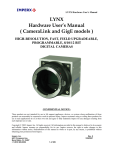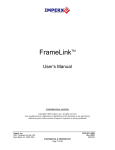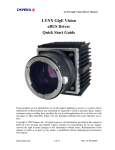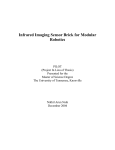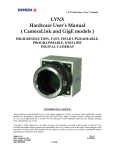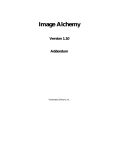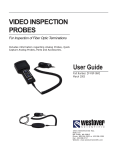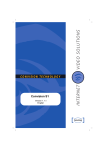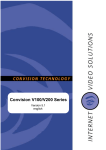Download User`s Manual
Transcript
VCE Express TM User’s Manual CONFIDENTIAL NOTICE: Copyright 2009, Imperx, Inc. All rights reserved. Any unauthorized use, duplication or distribution of this document or any part thereof, without the prior written consent of Imperx Corporation is strictly prohibited. Imperx, inc. 6421 Congress Ave Ste. 204 Boca Raton, FL 33487 USA DOC-0016-0002 Rev. RA03 09/18/13 CONFIDENTIAL & PROPRIETARY Page 1 of 65 Revision History RA01 RA02 RA03 Jul-29-2009 Dec-29-2009 Sep-11-2013 J. Egri J. Egri J. Egri Initial Release Revised Capture Settings dialog Added Appendix B - Cabling Page 2 of 65 Table Of Contents CHAPTER 1 - INTRODUCTION..............................................................................................................................5 VCE EXPRESS ............................................................................................................................................................6 WHAT YOU NEED TO GET STARTED ........................................................................................................................... 12 INSPECTING THE VCE EXPRESS PACKAGE ................................................................................................................ 13 CHAPTER 2 – HARDWARE INSTALLATION ................................................................................................... 14 CHAPTER 3 – SOFTWARE INSTALLATION .................................................................................................... 15 SOFTWARE SUITE ..................................................................................................................................................... 15 SOFTWARE INSTALLATION FROM CD ....................................................................................................................... 17 SOFTWARE UPGRADE FROM WEB SITE ..................................................................................................................... 21 FIRMWARE UPGRADE FROM WEB SITE ..................................................................................................................... 22 CHAPTER 4 – USING THE VCE EXPRESS ........................................................................................................ 23 RUNNING THE VCE EXPRESS APPLICATION ............................................................................................................. 24 MAIN WINDOW ........................................................................................................................................................ 25 CONTROL PANEL DIALOG ........................................................................................................................................ 29 VIDEO SIZE DIALOG ................................................................................................................................................. 33 COLOR SPACE CONVERTER DIALOG ......................................................................................................................... 35 RGB CONTROL DIALOG ........................................................................................................................................... 36 RGB LOOKUP TABLE DIALOG .................................................................................................................................. 37 CAPTURE SETTINGS DIALOG .................................................................................................................................... 39 STATISTICS DIALOG ................................................................................................................................................. 46 HEX PIXEL DUMP WINDOW ...................................................................................................................................... 47 HISTOGRAM WINDOW .............................................................................................................................................. 50 ZOOM MENU ............................................................................................................................................................ 51 PLAYER CONTROL .................................................................................................................................................... 52 PLAYER DIALOG ....................................................................................................................................................... 54 CHAPTER 5 – ELECTRICAL INTERFACES ...................................................................................................... 55 VIDEO CONNECTOR .................................................................................................................................................. 56 EXPRESSCARD CONNECTOR ..................................................................................................................................... 57 CHAPTER 6 - SPECIFICATIONS.......................................................................................................................... 58 APPENDIX A – CREATING LOOKUP TABLES ................................................................................................ 59 A.1 OVERVIEW ......................................................................................................................................................... 60 A.2 USING AN ASCII TEXT EDITOR .......................................................................................................................... 60 A.3 USING MICROSOFT EXCEL ................................................................................................................................. 61 APPENDIX B – CABLING ...................................................................................................................................... 62 B.1 OVERVIEW ......................................................................................................................................................... 63 B.2 CABLE DRAWING ............................................................................................................................................... 63 B.3 CABLE INTERCONNECT ...................................................................................................................................... 64 B.4 TRIGGER PIN-OUT .............................................................................................................................................. 65 Page 3 of 65 Illustrations Figure 1 – VCE Express Block Diagram .......................................................................................................................8 Figure 2 – Color Space Converter ............................................................................................................................... 10 Figure 3 – Main dialog ................................................................................................................................................ 25 Figure 4 – Control Panel dialog ................................................................................................................................... 29 Figure 5 – Video Size dialog ....................................................................................................................................... 33 Figure 6 – Color Space Converter dialog .................................................................................................................... 35 Figure 7 – RGB Control dialog ................................................................................................................................... 36 Figure 8 – RGB Lookup Table dialog ......................................................................................................................... 37 Figure 9 – Examples of custom lookup table transformations ..................................................................................... 38 Figure 10 – Capture Settings dialog ............................................................................................................................ 39 Figure 11 – AVI Setup dialog ...................................................................................................................................... 40 Figure 12 – Trigger options ......................................................................................................................................... 42 Figure 13 – Out-of-Memory error ............................................................................................................................... 43 Figure 14 – Statistics dialog ........................................................................................................................................ 46 Figure 15 – Sample image with Hex Dump region ..................................................................................................... 48 Figure 16 – Hex Dump for YCrCb mode .................................................................................................................... 49 Figure 17 – Hex Dump for RGB-24 mode .................................................................................................................. 49 Figure 18 – Histogram window ................................................................................................................................... 50 Figure 19 – Zoom menu .............................................................................................................................................. 51 Figure 20 – Player Control dialog................................................................................................................................ 52 Figure 21 – Player Dialog ............................................................................................................................................ 54 Figure 22 – External trigger schematic ........................................................................................................................ 56 Tables Table 1 – Pixel mapping into memory : YCrCb 4:2:2 mode – 4 pixels/DW .................................................................9 Table 2 – Pixel mapping into memory : YCrCb 4:4:4 mode – 2 pixels/DW .................................................................9 Table 3 – Pixel mapping into memory : RGB-24 mode – 2 pixels/DW ........................................................................9 Table 4 – Video Connector Pin-out ............................................................................................................................. 56 Table 5 – ExpressCard Connector Pin-out .................................................................................................................. 57 Page 4 of 65 Chapter 1 - Introduction Introduction This chapter outlines the key features of the Imperx VCE Express card. Page 5 of 65 VCE Express The VCE Express frame grabber is a 54mm ExpressCard with both an NTSC/PAL analog interface and a PCI Express x1 lane interface. It provides the ability to capture analog NTSC/PAL video data, from either a CVBS or S-Video source, and transfer that data to host memory via an ExpressCard ( PCIe ) interface. Functionality • • • • • • Provides two composite or S-Video inputs. Captures video data from a standard NTSC, PAL, SECAM or RS170 analog source, formats this data and stores it into local FIFOs. Data can be formatted as 16 bit YCrCb 4:2:2, 16 bit YCrCb 4:4:4 or as 24 bit RGB. Retrieves the formatted data from the FIFOs and transfers it into host memory via a scatter/gather DMA over the x1 lane PCI Express interface. Provides an external triggering capability that can qualify image capture based on an external signal. Provides the ability to upgrade the FPGA firmware in the field by the user. Interfaces Analog interface The VCE Express provides two CVBS ( composite ) or two S-Video inputs using either an 8-pin circular connector ( model VCE-EXPRESS ) or discrete embedded cables ( model VCE-EXPRESS-F ). ExpressCard interface The VCE Express provides a ExpressCard/54 compliant interface. This supports a x1 lane ‘end-point’ PCI Express interface as defined in the ExpressCard standard. The design does not support any memory mapped or I/O mapped peripherals on the card. Access to the card’s pixel data FIFOs is achieved through DMA operations that move the data from the FIFOs into host memory. Access to the card’s pointer queue FIFOs is achieved through DMA operations that move the data from host memory into the FIFOs. The host cannot directly access the contents of either of these FIFOs. The design supports host access into PCI Express configuration registers as well as application specific frame grabber registers. Page 6 of 65 The ExpressCard standard also defines a Universal Serial Bus ( USB ) and a Serial Management Bus ( SMBus ) interface on the ExpressCard connector. These interfaces are unused in the VCE Express card design. Page 7 of 65 A functional block diagram of the VCE Express card is illustrated in Figure 1. JTAG ByteBlaster Programming Header Configuration EEPROM EPCS64 ExpressCard Connector TxD 8 TxCLK TxStrobes TxD RxD CLK 2 2 2 Analog Video Connector PCI Express PHY Y C RxD 8 RxCLK RxStrobes 2.5V 3.3V 3.3V-to-2.5V converter 8 8 Strobes 3 RxClk ALTERA Cyclone3 FPGA I2C_SCL 2.5V-to-1.25V converter 3.3V 3.3V-to-1.2V converter Video Decoder I2C_SDA Trigger Detector 1.25V 2.5V Philips SAA7115 1.2V Figure 1 – VCE Express Block Diagram Page 8 of 65 CVBS0/Y0 CVBS1/Y1 C0 C1 Video Capture The video capture engine is responsible for receiving video pixel data and qualifiers from the video decoder, formatting the data and transferring it into on-board memory. The module receives 16 bits of video data organized as 8 bits of Luma data and 8 bits of Chroma data as well as VSYNC, HSYNC and DATA_EN strobes. The received video data is formatted as YCrCb 4:2:2. The video capture module supports three modes of operation, as configured by the user: - YCrCb-4:2:2 mode – uses the 16 bit YCrCb 4:2:2 data received from the video decoder. • YCrCb-4:4:4 mode – uses the 16 bit YCrCb 4:2:2 data received from the video decoder and translates it to 24 bit YCrCb 4:4:4 data using a chroma resampler function. • RGB-24 mode – uses the 16 bit YCrCb 4:2:2 data received from the video decoder and translates it to 24 bit YCrCb 4:4:4 data using a chroma resampler function and then generates 24 bit RGB data using a color space converter function. The video_capture module translates the video data into doublewords ( 64 bits ) as defined in tables 3.2 thru 3.4. These formats reflect how the data will appear in host memory. d31 d63 Cr7 Cr7 d30 d62 Cr6 Cr6 d29 d61 Cr5 Cr5 d28 d60 Cr4 Cr4 d27 d59 Cr3 Cr3 d26 d58 Cr2 Cr2 d25 d57 Cr1 Cr1 d24 d56 Cr0 Cr0 d23 d55 Y7 Y7 d22 d54 Y6 Y6 d21 d53 Y5 Y5 d20 d52 Y4 Y4 d19 d51 Y3 Y3 d18 d50 Y2 Y2 d17 d49 Y1 Y1 d16 d48 Y0 Y0 d15 d47 Cb7 Cb7 d14 d46 Cb6 Cb6 d13 d45 Cb5 Cb5 d12 d44 Cb4 Cb4 d11 d43 Cb3 Cb3 d10 d42 Cb2 Cb2 d9 d41 Cb1 Cb1 d8 d40 Cb0 Cb0 d7 d39 Y7 Y7 d6 d38 Y6 Y6 d5 D4 d37 d36 Y5 Y4 Y5 Y4 d3 d35 Y3 Y3 d2 d34 Y2 Y2 d1 d0 d33 d32 Y1 Y0 YCrCb Y1 Y0 4:2:2 d3 d35 Y3 Y3 d2 d34 Y2 Y2 d1 d0 d33 d32 Y1 Y0 YCrCb Y1 Y0 4:4:4 d3 d35 B3 B3 d2 d34 B2 B2 d1 d0 d33 d32 B1 B0 RGB B1 B0 24 Table 1 – Pixel mapping into memory : YCrCb 4:2:2 mode – 4 pixels/DW d31 d30 d29 d28 d27 d26 d25 d24 D23 d22 d21 d63 d62 d61 d60 d59 d58 d57 d56 D55 d54 d53 - Cr7 Cr6 Cr5 - Cr7 Cr6 Cr5 d20 d52 Cr4 Cr4 d19 d51 Cr3 Cr3 d18 d50 Cr2 Cr2 d17 d49 Cr1 Cr1 d16 d48 Cr0 Cr0 d15 d47 Cb7 Cb7 d14 d46 Cb6 Cb6 d13 d45 Cb5 Cb5 d12 d44 Cb4 Cb4 d11 d43 Cb3 Cb3 d10 d42 Cb2 Cb2 d9 d41 Cb1 Cb1 d8 d40 Cb0 Cb0 d7 d39 Y7 Y7 d6 d38 Y6 Y6 d5 D4 d37 d36 Y5 Y4 Y5 Y4 Table 2 – Pixel mapping into memory : YCrCb 4:4:4 mode – 2 pixels/DW d31 d30 d29 d28 d27 d26 d25 d24 d23 d22 d21 d63 d62 d61 d60 d59 d58 d57 d56 d55 d54 d53 - R7 R6 R5 - R7 R6 R5 d20 d52 R4 R4 d19 d51 R3 R3 d18 d50 R2 R2 d17 d49 R1 R1 d16 d48 R0 R0 d15 d47 G7 G7 d14 d46 G6 G6 d13 d45 G5 G5 d12 d44 G4 G4 d11 d43 G3 G3 d10 d42 G2 G2 d9 d41 G1 G1 d8 d40 G0 G0 d7 d39 B7 B7 d6 d38 B6 B6 Table 3 – Pixel mapping into memory : RGB-24 mode – 2 pixels/DW Page 9 of 65 d5 D4 d37 d36 B5 B4 B5 B4 Chroma Resampler This module is responsible for receiving YCrCb 4:2:2 video pixel data from the video decoder, performing a coset function and delivering YCrCb 4:4:4 formatted data. For example: Input 4:2:2 data : Y1/Cb1, Y2/Cr2, Y3/Cb3, Y4/Cr4 … Output 4:4:4 data : Y1/Cb1/Cr2, Y2/Cb1/Cr2, Y3/Cb3/Cr4, Y4/Cb3/Cr4 … Color Space Converter This module is responsible for receiving YCrCb 4:4:4 video pixel data from the chroma_resampler module, performing color space conversion and delivering RGB-24 formatted data. The following parameters are configurable by the user: Offsets Coefficients Limits Y[7:0] Cr[7:0] : Yoff, CRoff and CBoff : Y1, R1, G1, G2 and B1 : R_min, R_max, G_min, G_max, B_min and B_max Yoff Y1 - x CRoff R1 - x Min + Max Limit R[7:0] - G1 x - G2 Min + Max Limit G[7:0] x Cb[7:0] CBoff B1 - x Min + Figure 2 – Color Space Converter Page 10 of 65 Max Limit B[7:0] Pixel Buffering The pixel data formatted by the video capture engine is stored into two on-board FIFO memories. This memory serves as an elastic store for formatted video pixel data. The FIFOs are managed by an independent pair of controllers, implemented in the FPGA, supporting concurrent operation. The two FIFOs are utilized in a ping-pong fashion such that while one is being filled with new pixel data, the other is being emptied via DMA into host memory. DMA The DMA engine is responsible for reading formatted pixel data from the on-board FIFO memories and transferring them into host memory via the ExpressCard interface. An intelligent scatter-gather method is utilized, providing for an efficient use of the ExpressCard bandwidth. The use of non-contiguous 4Kbyte buffers provides support for the Windows operating system’s memory allocation model. FPGA The heart of the VCE Express is a dense Field Programmable Gate Array ( FPGA ). This FPGA implements all of the functions related to video data capture, formatting, storage and DMA. The firmware contents of the FPGA can be upgraded while in the field by following the instruction outlined in Section 3 of this document entitled ‘Firmware Upgrade from Web Site’. Page 11 of 65 What you need to get started To begin using the VCE Express card, you need the following: • A computer with a ExpressCard/54 slot. • Microsoft Windows XP/2000/Vista operating system software. • A computer with at least 256M bytes of RAM. • A CD drive, and a hard disk on which to install the VCE Express software. Page 12 of 65 Inspecting the VCE Express package When you unpack your VCE Express package, you should visually inspect all of its contents. If something is missing or damaged, contact your Imperx representative. Package contents You should have received the following items: • The VCE Express card • A VCE Express cable ( circular plug to S-Video connectors ) • An adapter cable ( S-Video to RCA ) • A CD with the VCE Express software suite • A ‘Quick Start’ installation guide Page 13 of 65 Chapter 2 – Hardware Installation Hardware Installation Installing the VCE Express card is as simple as plugging it into an available ExpressCard/54 slot on your computer. Page 14 of 65 Chapter 3 – Software Installation Software Installation This chapter explains how to install the VCE Express software. Software Suite The VCE Express software suite consists of the following files: Windows application files: ( located in C:\Program Files\ImperX\VCE Express\Application\Win32 and C:\Program Files\ImperX\VCE Express\Application\x64 ) VCE Express.exe VCEANCB.dll DrvManager.exe VCE Express.chm - Application program - VCE Express SDK library - Driver debug utility - Help file ippLib.dll IpxLog.dll IpxMisc.dll IpxMovieMaker.dll DSMovieWriter.ax - Intel image processing library - Imperx logging library - Imperx miscellaneous library - Imperx movie maker library - Movie Writer DirectShow filter Windows driver files: ( located in C:\Program Files\ImperX\VCE Express\Drivers\Kernel\ ) - WinXP/2000/Vista kernel driver files Software Development Kit ( SDK ) files: ( located in C:\Program Files\ImperX\VCE Express\SDK\ ) /bin/ folder /doc/ folder - binaries - documentation Page 15 of 65 /examples/ folder /inc/ folder /lib/ folder - sample source code - include files - libraries Documentation files: ( located in C:\Program Files\ImperX\VCE Express\Doc\ ) VCE_Express_Users_Manual.pdf VCE_Express_Datasheet.pdf QUICK START VCE_EXPRESS.pdf - User manual document - Technical datasheet - Quick start manual Note that our VCE Express application program was created using our SDK ( software developers kit ). Our SDK is included in the standard VCE Express software suite that comes with the card. Page 16 of 65 Software Installation from CD Use the following steps to install the VCE Express software supplied on a CD. Note that ‘click’ refers to the left mouse button. 1. If a version of VCE Express was previously installed on this machine, then you must first remove it: To remove the application files: 1.1 1.2 1.3 1.4 1.5 1.6 1.7 1.8 1.9 2. Click on “Start” Click on “Settings”. Click on “Control Panel”. Double click on “Add or Remove Programs”. Click on “VCE Express”. Click on “Remove”. If the ‘VCE Express – InstallShield Wizard’ pops-up then do the following, otherwise go to step 1.8 Click on ‘Remove’. Click ‘Next’. Click ‘Yes’. Click ‘Finish’. Click on “Yes”. Click on “Close”. After having removed a previous version or if a version of VCE Express was NOT previously installed on this machine then: The first step is to install the application files: 2.1 2.2 2.3 2.4 Insert the VCE Express CD into the appropriate drive; the setup.exe file will run automatically. Note: If it does not start automatically, then click on “Start”, “Run”, enter or browse to “(CD drive): setup.exe” and click “OK”. Wait for the “VCE Express - InstallShield Wizard” screen to appear. Follow the on-screen instructions. For Windows Vista 32 bit and Windows Vista 64 bit, select “Always trust software from Imperx, Inc.” and click on “Install” button, when the following message appears: Page 17 of 65 2.5 When the following message appears, choose if you would like to register online by clicking on “Register now”. 2.6 Click “Next” and then “Finish”. This completes the software installation. Reboot your computer. 2.7 The next step is to install the driver files: 2.8 2.9 2.10 Insert the VCE Express card into the laptop. For XP: Wait for the system to prompt you with a “Found New Hardware Wizard” dialog box. Proceed to Step 2.10. For Vista: The driver will automatically be installed. Proceed to step 2.15. Under certain conditions, the following message may appear: Page 18 of 65 If this message appears, click “No, not this time”, then click “Next”. 2.11 When the following message appears, select “Install the software automatically (Recommended)”, then click “Next”. 2.12 The following message will appear: Page 19 of 65 2.13 2.14 2.15 Click “Continue Anyway” to continue. When “Click finish to close the wizard” appears, click on “Finish”. This completes the driver installation. Page 20 of 65 Software Upgrade from Web Site New application and/or driver software may be released periodically to reflect improvements and/or functionality added to the VCE Express. You can retrieve these updates by visiting the download page of our web site at: http://www.imperx.com/frame_grabbers/VCE Express/VCE_Express_downloads.php Use the following steps to install newly released application software: 3.1 3.2 3.3 3.4 3.5 Uninstall all application files by following the instructions in step 1. of the ‘Software Installation from CD’ section. Download the VCE_Express_Installer.exe file from the Imperx web site to a new folder on your PC ( we will use the folder C:\new_VCE_Express as an example ). Left mouse click on “Start”, “Run”, enter or browse to C:\new_VCE_Express\VCE_Express_Installer.exe. Left mouse click on “Open”, then “OK”. Follow the instructions starting from step 2.2 above. Page 21 of 65 Firmware Upgrade from Web Site Your newly received VCE Express card has been programmed in the factory with the latest firmware prior to shipping. New firmware, however, may be released periodically to reflect improvements and/or added functionality. You can retrieve these updates by visiting the download page of our web site at: http://www.imperx.com/frame_grabbers/VCE Express/VCE_Express_downloads.php Use the following steps to install newly released firmware: 1. 2. 3. 4. 5. Download and unzip the firmware Upgrade Utility file to a folder on your PC. Insert the VCE Express card into the laptop. Note that if your system has two ExpressCard slots, then you must insert the card into the slot in which it was placed during the original driver installation. If the system prompts you with a “New Hardware Found” dialog box, then you have not previously installed the driver. You must follow the steps outlined in the section above titled “Software Installation from CD” to install the driver. To run the Upgrade Utility simply double click on the icon. Note: DO NOT POWER DOWN OR REMOVE THE CARD WHILE PROGRAMMING IS IN PROGRESS! The Upgrade Utility will display the following dialog box: Page 22 of 65 Chapter 4 – Using the VCE Express Using the VCE Express card This chapter contains information on how to configure and use the VCE Express card. Page 23 of 65 Running the VCE Express Application The VCE_Express.exe program supplied with the VCE Express card is a stand-alone Windows based application. It provides an easy to use graphical user interface ( GUI ), allowing the user to configure the VCE Express card and to view, record and playback video data received from the analog interface. The application consists of a main window as well as several other dialogs which can be accessed from the main menu or from convenient icons. Launching Application To launch the VCE Express program, simply double left mouse click on the ‘VCE Express Application’ icon on the desktop. Note In the remainder of this chapter, references to ‘clicking’ on objects in the GUI refers to the left mouse button. Page 24 of 65 Main Window When the VCE Express application is executed, a main window titled ‘VCE Express’ will appear. The main window provides the primary area for viewing real-time images received from the video source. This window can be sized and moved to suit your needs. When image viewing is active, the size of this window will automatically be scaled as a function of the input signal. Figure 3 – Main dialog The Main dialog contains a Menu bar, an Icon bar and a Status bar. Menu Bar The Menu bar includes a set of pull-down sub-menus as follows: File Clicking on this item reveals a pull-down menu with two options: ‘Player’ and ‘Exit’. Play Files This option opens the ‘Player Dialog’ and ‘Player Control’ windows. Exit Clicking on this option causes the program to terminate. Page 25 of 65 View Clicking on this item reveals a pull-down menu with the following options: Control Panel Causes the ‘Control Panel’ dialog to appear. Video Size Causes the ‘Video Size’ dialog to appear. Color Space Converter Causes the ‘Color Space Converter’ dialog to appear. RGB Control Causes the ‘RGB Control’ dialog to appear. RGB Lookup Table Causes the ‘RGB Lookup Table’ dialog to appear. Capture Settings Causes the ‘Capture Settings’ dialog to appear. Statistics Causes the ‘Statistics’ dialog to appear. Hex Pixel Dump Causes the ‘Hex Pixel Dump’ dialog to appear. Histogram Causes the ‘Histogram’ dialog to appear. Zoom Causes the ‘Zoom’ menu to appear. Help Clicking on this item reveals a pull-down menu with two options: ‘About’ and ‘Help Manual’. About Causes version information to be displayed including release identifiers for the application software, library, driver and firmware. This information should be provided to Imperx technical support personnel during a service call. Help Manual Causes an interactive point-and-click style help manual to be displayed. The help manual provides a summary description of all GUI controls and fields. Page 26 of 65 Icon Bar The Icon bar contains a set of icons that act as shortcuts into the features located on the Menu bar. Start/stop continuous Grab Snap single frame Start/stop Capture to disk Open Control Panel dialog Open Video Size dialog Open Color Space Converter dialog Open RGB Control dialog Open RGB Lookup Table dialog Open Capture Settings dialog Open Statistics dialog Open Hex Pixel Dump dialog Open Histogram dialog Zoom In Zoom Out Fit to Window Zoom 1:1 Turn Grid on/off Help Page 27 of 65 Status Bar The Status bar reflects the real-time state of the current video source connection. Camera Rate Displays the real-time frame rate of the attached video source as measured at the input of the VCE Express card. Grabbing Rate Displays the real-time rate at which frames are being transferred from the card into host memory. Grabbing Count Displays a running count of the total number of frames transferred into system memory. This counter is reset when ‘grabbing’ is stopped. Pixel Position Displays the x,y coordinates of the pixel at the current mouse position. Pixel Value Displays the decimal value of the pixel at the current mouse position. If the mode is YCrCb then the Y, Cr and Cb values will be displayed. If the mode is RGB-24, then the R, G and B values will be displayed. DMA Status Displays the real-time status of the DMA process as being either ‘active’ or ‘inactive’. ‘Active’ indicates that the user has commanded the VCE Express to acquire video data by clicking on the ‘Start Grab’ button and that the video source is providing valid framing. ‘Inactive’ indicates that either the user has commanded the VCE Express to stop acquiring video data by clicking on the ‘Stop Grab’ button or that grabbing is enabled but the video source is not providing valid framing. Camera Status Displays the real-time status of the attached video source as being either ‘online’ or ‘offline’. ‘Online’ indicates that a video source is powered on, attached and providing a video clock via the analog interface. ‘Offline’ indicates that the VCE Express card is not receiving a video clock from the attached source either because the source is powered off or the video cable is disconnected. Page 28 of 65 Control Panel Dialog The Control Panel dialog allows the user to control the operating parameters of the VCE-Express card and also reports the attributes of the attached video source. Figure 4 – Control Panel dialog Input Channel Controls the video source selection. Composite Select this if the video source is a composite signal. S-Video Select this if the video source is an S-Video signal. Channel 1 Select this if the video source is connected to input channel #1. Channel 2 Select this if the video source is connected to input channel #2. Input video signal These fields describe the attributes of the currently connected video source. The fields are automatically populated by the application program. Video Standard Indicates the format of the connected video source as either ‘NTSC’ or ‘PAL’. Mode Indicates the mode as either ‘Progressive’ or ‘Interlaced’. Page 29 of 65 Rate (fps) Indicates the rate of the connected video source. If the mode is progressive then the rate is in units of ‘frames per second’. If the mode is interlaced, then the rate is in units of ‘fields per second’. Locked Indicates that the card is locked to an incoming video signal. De-Interlacing These options control how to process the odd and even fields of an interlaced input video signal. Merge Fields Instructs the card to interleave lines from the odd and even fields to produce a progressive frame. For example: for a 640*480 input, the resultant progressive frame will consist of: Line1 = odd_field_line1 Line2 = even_field_line1 Line3 = odd_field_line2 Line4 = even_field_line2 : Line479 = odd_field_line240 Line480 = even_field_line240 Duplicate Fields Instructs the card to duplicate every line of the odd field to produce the resultant frame. The even field is ignored. For example: for a 640*480 input, the resultant frame will consist of: Line1 = odd_field_line1 Line2 = odd_field_line1 Line3 = odd_field_line2 Line4 = odd_field_line2 : Line479 = odd_field_line240 Line480 = odd_field _line240 Input Color Carrier Level This selection informs the card of the strength on the incoming color signal. If the input signal’s strength is low ( due to a worn VCR head or excessive cabling ) then set this field to ‘Low’ otherwise set it to ‘Normal’. Color Settings Specifies the video mode as either monochrome or color. Output These fields determine how the card should process the incoming video data. Format Indicates how the card should format the video data prior to transferring it into host system memory. Page 30 of 65 YCrCb – 4:2:2 Use the 16 bit YCrCb 4:2:2 data received from the video decoder as is. YCrCb – 4:4:4 Use the YCrCb 4:2:2 data received from the video decoder and translate it to YCrCb 4:4:4 data using a chroma resampler function. RGB - 24 bit Use the YCrCb 4:2:2 data received from the video decoder, translate it to YCrCb 4:4:4 data using a chroma resampler function and then generate 24 bit RGB data using a color space converter function. Transfer as Indicates how the card should transfer the video data into host system memory when the mode is ‘interlaced’. Note that when the mode is ‘progressive’ then the ‘frames’ option is automatically selected. Frames Interlaced: Progressive: Fields Image Control Transfer as a complete frame consisting of an odd field followed by an even field. Transfer as a complete frame with odd and even fields interlaced ( i.e. as received from the video source ). Transfer each field individually. These controls allow the user to adjust the brightness, contrast, hue and saturation of the image. Brightness Moving the slider right increases brightness causing more white while moving it left decreases brightness causing less white. Contrast Moving the slider right increases contrast causing greater differences between dark and light while moving the slider left decreases contrast causing fewer differences between dark and light. Hue Moving the slider right increases hue causing an increase in the intensity of Red and Yellow while moving the slider left causes an increase in the intensity of Blue and Green. Saturation Moving the slider right increases saturation causing white to be removed from the colors while moving the slider left decreases saturation causing white to be added to the colors. Reset Causes the slider to revert back to its default setting. Gain Control Determines how the video decoder’s AGC ( automatic gain control ) circuit processes the incoming video signal. Page 31 of 65 Auto Enables the video decoder’s AGC circuit to automatically adjust the gain. Manual Disables the video decoder’s AGC circuit and instead applies the gain selected by the slider. Apply Causes the application to apply the current settings to the VCE Express card. Start/Stop Grab This button will toggle between ‘Start Grab’ and ‘Stop Grab’ every time the user clicks on it. Clicking on ‘Start Grab’ enables the VCE Express’s DMA engine and causes the main window to display live images received from the video source. Clicking on ‘Stop Grab’ disables the DMA engine and causes the display to freeze. Page 32 of 65 Video Size Dialog The Image Size dialog allows the user to ‘crop’ the size of the incoming image. Some video sources produce extra black columns or rows that the user may wish to remove from the image. There are two ways to remove these extraneous pixels: manually using the ‘Input video signal’ parameters or automatically using the ‘Auto Crop’ feature. The Image Size dialog also allows the user to ‘scale’ the size of the output ( displayed ) image. The user can up-scale or down-scale the image in order to produce an image that matches his screen’s resolution. Figure 5 – Video Size dialog Input video signal Allows the user to manually crop the image. Note that as an alternative to using the sliders, the user can enter the start and end values into the edit boxes. H: This slider defines the starting and ending horizontal pixels in each row and thereby deletes any leading ( left most ) or trailing ( right most ) columns in the image. V: This slider defines the starting and ending vertical lines and thereby deletes any leading ( top most ) and trailing ( bottom most ) rows in the image. Output video size H: Allows the user to manually scale ( up or down ) the size of the image to be displayed. For example: the input size may be 720*480 but the image to be displayed can be down-scaled to 640*480. Note that as an alternative to using the sliders, the user can enter the width ( H ) and height ( Y ) values into the edit boxes. This slider defines the width ( i.e. number of horizontal pixels in each row ) of the image to be displayed. Page 33 of 65 V: This slider defines the height ( i.e. number of vertical lines ) of the image to be displayed. Auto Crop Clicking on this button invokes an algorithm performed by the VCE-Express software that scans an image from left-to-right, right-to-left, top-to-bottom and bottom-to-top looking for a transition in the pixel intensity from black to a threshold value. It will then note the number of black pixels and adjust the H: and V: parameters accordingly. Threshold This field allows the user to define the threshold value to be used by the Auto Crop algorithm. Default Click this button to revert back to the default H: and V: settings. Page 34 of 65 Color Space Converter Dialog The Color Space Converter dialog allows the user to adjust the behavior of the color space conversion function. This function is responsible for converting from YCrCb video data to the RGB-24 format. Note that if either the YCrCb-4:2:2 or YCrCb-4:4:4 mode is selected, then YCrCb data is delivered from the card into host memory and therefore the color space conversion function is performed by software. However, if RGB-24 mode is selected, then the color space conversion is performed on the card and RGB-24 data is delivered from the card into host memory. Figure 6 – Color Space Converter dialog Default Sets all parameters back to their default values. Apply Instructs the color space converter function to use the values entered into the various fields. Note that entering values into the fields will not have an effect on the image until the ‘Apply’ button is clicked. Page 35 of 65 RGB Control Dialog The RGB Control dialog allows the user to adjust the gain and offset for each of the RGB color components. Optionally, the gains can be set automatically by invoking a white balance function. Note that if either the YCrCb-4:2:2 or YCrCb-4:4:4 mode is selected, then YCrCb data is delivered from the card into host memory and therefore the RGB control function is performed by software. However, if the RGB-24 mode is selected, then the RGB control is performed on the card and RGB-24 data is delivered from the card into host memory. Figure 7 – RGB Control dialog RGB Offset Specifies the amount of offset to apply to each of the R, G and B components. RGB Gain Specifies the amount of gain to apply to each of the R, G and B components. Unity White balance Analyze This button sets all gains to a value of 1.0000. Performs an automatic white balancing procedure. Instructs the VCE Express card to analyze the current image received from the video source and to calculate a set of RGB Gain coefficients that will cause the sample image to be white balanced. NOTE: Before clicking on ‘Analyze’, the user should reset all gains to unity and point the video source at a uniform white target. Apply Instructs the VCE Express card to use the calculated RGB Gain coefficients acquired during the ’analyze’ procedure and to apply these to the received image prior to display. Page 36 of 65 RGB Lookup Table Dialog The RGB Lookup Table feature allows the user to modify and transform the original video data. The pixel values for each of the R, G and B components can be mapped into new values. The mapping from input to output values is defined in a lookup table ( LUT ) file. The LUT file is an ASCII text file that can be created and modified by the user ( see Appendix A for details ) or can be automatically generated by the VCE Express application. Gamma Correction and custom Lookup Tables using the GUI Gamma correction is the process of compensating for the non-linearity of CRT displays. The VCE Express application can automatically create gamma lookup tables. It can also create custom lookup tables using an interactive drawing feature. Figure 8 – RGB Lookup Table dialog Gamma/Pencil This pull-down menu specifies the ‘gamma’ or ‘pencil’ mode of operation. In the ‘pencil’ mode, the user can use the mouse to draw the desired transfer function directly on each graph. In the ‘gamma’ mode, the user can enter an explicit gamma value or use the up/down arrows to increment/decrement the value or move the slider to the desired value. Using ‘G’ as the gamma coefficient, the gamma correction equation is: Output_value = [(Input_value/255)G] * 255 Reset This button sets the gamma edit box to a value of 1.000. Page 37 of 65 Enable Selecting this check box turns on LUT processing. Note that prior to enabling LUT processing, an LUT file must first be ‘transferred’ into the card. Load table… Opens a Windows ‘browse’ box allowing the user to select a folder and filename for the LUT file to be opened. The lookup table specified will be opened and plotted in the three graphs. The LUT file can be any file, custom or gamma, that follows the format specified in Appendix A. Save table… Opens a Windows ‘browse’ box allowing the user to select a folder and filename for the current LUT file to be saved. The filename extension, .lut, will automatically be added and therefore you do not need to include the filename extension. Transfer to card Causes the current lookup table, displayed in the graphs, to be loaded into the VCE Express card. Custom Lookup Tables using an LUT file Custom arbitrary transformations for the purposes of knee correction, contrast enhancement, negative image, etc. can also be implemented. This requires that the user specify the transformation via an LUT file ( see Appendix A for details ). Custom Transfer Function Double Knee Correction Contrast enhancement Negative Image Figure 9 – Examples of custom lookup table transformations Page 38 of 65 Capture Settings Dialog This dialog gives the user complete control over image storage. Figure 10 – Capture Settings dialog Start/Stop Capture This button will toggle between ‘Start Capture’ and ‘Stop Capture’ every time the user clicks on it. Clicking on ‘Start Capture‘ starts the process of recording the images to disk. The options set in the fields above it determine what, how and when actual recording is performed. Clicking on ‘Stop Capture’ causes recording to stop. Page 39 of 65 Image Format When recording images to disk, this option selects the format, ‘BMP’, ‘JPEG’, ‘TIFF’, ‘AVI’ or ‘RAW’, that the image will be saved in. Selecting ‘JPEG’ activates a compression slider. ‘Best’ provides the least compression, while ‘Small’ provides the most compression. Selecting ‘AVI’ enables the ‘AVI Setup’ dialog to be opened. AVI Setup Allows the user to configure AVI parameters. An AVI movie is a series of images assembled into a single AVI file. Figure 11 – AVI Setup dialog Frames per Second Limits the frame rate of the recorded movie. Learn from card Clicking on this button causes the actual frame rate of the attached video source to be read from the card and automatically populated into the ‘Frame per Second’ field. Compressor Allows you to choose between a variety of compressor implementations and options. This pull-down menu lists several different implementations of AVI compressors. Each has its own set of configuration options. OK Causes the application to apply the current settings to the VCE Express card and then closes the AVI Setup dialog. Cancel Closes the AVI Setup dialog without applying the changes. Text Overlay Creates text to be overlayed on top of the captured image. Insert Date and Time Automatically overlays the date and time, received from the PC’s operating system, on each image recorded. Date and time formats are the same as those used on your computer. Insert Timestamp Automatically overlays an accurate timestamp on each image recorded. The timestamp is a decimal integer value indicating the time, in microseconds, when the card acquired the frame from the attached video source. Page 40 of 65 Insert Text Message Allows you to enter a text string to be automatically overlayed on each image recorded. Position Defines the placement position of the date/time/text message within the image. Available options include: Top-Left, Top-Center, Top-Right, Bottom-Left, Bottom-Center and Bottom-Right. File Name Selects the Path and Filename to be created. Save Folder This text field allows you to provide a path for the recorded image file. Clicking on the ‘…’ box will cause a Windows ‘browse’ box to appear. The user can then browse to a folder. File Prefix This text field allows you to provide a filename prefix for the recorded image file. The filename extension, .BMP, .JPG, .TIF, .AVI or .RAW, will automatically be added depending on the image format chosen and therefore you do not need to include the filename extension. Append to filename Allows the user to choose the format of the filename suffix to be created. Every time a recording file is created, the filename suffix will automatically be updated ( for the ‘Date and Time’ option ) or incremented ( for the ‘N Digit Number’ option ). Date and Time This option will create files named as YYYYMMDDhhmmssnnn where: Y - year (4 digits) M - month (2 digits) D - day (2 digits) h - hour (2 digits) m - minute (2 digits) s - second (2 digits) n - millisecond (3 digits) ‘N’ Digit Number This option will create numerically named files. The filename starts at 0 and is incremented by one after each frame is captured. If the number of frames captured exceeds the number of digits selected then the filename will continue to increment. For example, if the filename prefix is ‘image’ then: If ‘2 Digit Number’ is selected then the files will be named as: ‘image00.bmp’, ‘image01.bmp’ … ‘image99.bmp’, image100.bmp’, Page 41 of 65 ‘image101.bmp’, etc. If ‘4 Digit Number’ is selected then the files will be named as: ‘image0000.bmp’, ‘image0001.bmp’ … ‘image9999.bmp’, ‘image10000.bmp’, ‘image10001.bmp’, etc. Capture event occurs: Allows you to control how often to start capturing images. Continuous Specifies that image capture is free-running. Capturing begins as soon as the ‘Start Capture’ button is pressed. Capture every Specifies how often, in time, to start capturing images. Use this feature to take snapshots at regular intervals in order to create a time-lapse series of images. With Trigger When this option is selected, images will be captured when the ‘External Trigger’ signal becomes active. A drop-down menu allows the user to specify the conditions, of the ‘External Trigger’ signal, necessary to start image capture. Note that all triggers work in conjunction with the ‘Capture duration for each event’ and ‘Total capture’ settings. Figure 12 – Trigger options Trigger on rising edge Start capturing images when the trigger goes from low ( voltage absent ) to high ( voltage present ). Trigger on falling edge Start capturing images when the trigger goes from high ( voltage present ) to low ( voltage absent ). Trigger while high Start capturing images when the trigger is high ( voltage present ) and continue capturing images until the trigger goes low ( voltage absent ). Trigger while low Start capturing images when the trigger is low ( voltage absent ) and continue capturing images until the trigger goes high ( voltage present ). Page 42 of 65 Capture duration Allows you to control how much to capture with each capture event for each event: specified above. Limits can be specified by either time or number of frames, whichever occurs first. Limit capture time to Allows you to limit the duration of the recording by the amount of time specified. Limit number of frames to Allows you to limit the duration of the recording by the number of frames specified. Total capture: Allows you to control how much to capture over all events specified above. Limits can be specified by either time or number of frames, whichever occurs first. Limit total capture time to Allows you to limit the duration of the total recording by the amount of time specified. Limit total number of frames to Allows you to limit the duration of the total recording by the number of frames specified. NOTE: Setting this field to 0 causes an infinite number of frames to be captured. Clicking on ‘Stop Capture’ is required to stop capturing. Buffer frames to memory When selected will store images in system memory during capturing. When capturing is complete, the images in memory will be flushed to the disk drive. Select this option to improve capture performance ( i.e. the number of frames per second stored to disk ). If this option is not selected, images will be stored directly to disk and therefore capture performance will be limited by the disk’s transfer rate. Freeze preview window while capturing When selected will stop the live image in the main window from updating during capture, otherwise the image will remain live. Selecting this option improves capture performance ( i.e. the number of frames per second stored to disk ). NOTE: While capturing is in progress, if the host operating system denies the VCE Express application’s request to allocate more frame buffers in host memory then the following error message will appear. Figure 13 – Out-of-Memory error Page 43 of 65 Examples of how to use Capture timers and counters: Example #1: To capture 5 frames, every 1.5 hours, over a 12 hour period. Capture event occurs: Capture every: 01 Hr 30 Min 00 Sec Capture duration for each event: Limit number of frames to: 5 Total capture: Limit total capture time to: 12 Hr 00 Min 00 Sec Example #2: To capture 5 minutes worth of images, every 15 minutes and not to exceed a total of 250 images. Capture event occurs: Capture every: 00 Hr 15 Min 00 Sec Capture duration for each event: Limit capture time to: 00 Hr 05 Min 00 Sec Total capture: Limit total number of frames to: 250 Example #3: To capture 10 frames, every 1 hour, over a 6 hour period and not to exceed a total of 300 images. Capture event occurs: Capture every: 01 Hr 00 Min 00 Sec Capture duration for each event: Limit number of frames to: 10 Total capture: Limit total capture time to: 06 Hr 00 Min 00 Sec Limit total number of frames to: 300 Example #4: To capture continuously for a period of 2 hours and not to exceed a total of 100 images. Capture event occurs: Continuous Total capture: Limit total capture time to: 02 Hr 00 Min 00 Sec Limit total number of frames to: 100 Page 44 of 65 Example #5: To capture 1 frame with each rising–edge of the trigger signal and not to exceed a total of 25 images. Capture event occurs: With trigger Trigger on rising edge Capture duration for each event: Limit number of frames to: 1 Total capture: Limit total number of frames to: 25 Example #6: To capture 5 minutes worth of images with each falling– edge of the trigger signal and not to exceed a total of 100 images. Capture event occurs: With trigger Trigger on falling edge Capture duration for each event: Limit capture time to: 00 Hr 05 Min 00 Sec Total capture: Limit total number of frames to: 100 NOTE: In the above examples, capturing is enabled after the user clicks the ‘Start Capture’ button. The button then automatically changes to ‘Stop Capture’. The user can prematurely abort the capturing process by clicking on ‘Stop Capture’. Otherwise, the capturing process will automatically stop after the conditions defined in ‘Total capture’ are satisfied. Page 45 of 65 Statistics Dialog The Statistics dialog displays real-time status information about the current video source connection. Figure 14 – Statistics dialog Camera rate Displays the real-time frame rate of the attached video source as measured at the input of the VCE Express card. Grabbing rate Displays the real-time rate at which frames are being transferred from the card into host memory. Grabbing count Displays a running count of the total number of frames transferred into system memory. This counter is reset when ‘grabbing’ is stopped. Drop count Displays a running count of the total number of dropped frames. Dropped frames are defined as frames that were received from the video source but due to a lack of host buffers could not be transferred into host memory. It is the host computer’s responsibility to provide the card with pointers into host buffers. If the host computer cannot keep up with the incoming frame rate then the card will drop frames. The primary cause of this is background applications that are competing for the host processor’s time and preventing it from servicing the VCE Express card. Overrun count Displays a running count of the total number of receiver buffer overruns. Overruns are defined as pixel data that was received from the video source but due to a lack of space, in the card’s on-board receiver FIFOs, had to be discarded. Buffer overruns are an indication that the incoming pixel rate exceeds the bandwidth available on the ExpressCard interface. Timestamp Displays a running timestamp counter. Each frame that is received from the video source and transferred into host memory is time stamped. This field shows the timestamp value for the last frame processed. Page 46 of 65 Hex Pixel Dump Window The Hex Pixel Dump window displays a two-dimensional table of pixel values, plotting row ( Y ) vs. column ( X ), for a bounded region of pixels. The hexadecimal value of each pixel is displayed in each cell. For YCrCb formatted images, three values representing Y, Cr and Cb are displayed per pixel. For RGB-24 formatted images, three values representing R, G and B are displayed per pixel. Additionally, the background color of each cell is color encoded. Hovering the mouse over a given pixel reveals both the pixel’s hexadecimal and integer values. For example, in the RGB-24 sample hex dump of Figure 17, with the mouse positioned at location 156,55 ( X, Y ), a box is revealed showing that the value of the R,G,B components for the pixel at that location are BF,AA,CC in hexadecimal and 191,170,204 in integer. A yellow square, overlayed on the main image window, shows the position of the bounded region. Horizontal and vertical scroll bars allow the user to move the position of the bounded region of pixels anywhere within the entire frame. Another method of opening the Hex Pixel Dump window is to drag the mouse over the main image window while holding down the left mouse button. This creates the yellow box that defines the pixel dump’s bounded region and automatically open the Hex Pixel Dump window. Page 47 of 65 Figure 15 – Sample image with Hex Dump region In the sample image above, a Hex Dump region was opened starting at the upper left pixel coordinate ( X,Y ) of 146,52 and ending at the lower right pixel coordinate of 159,64. The yellow square indicates the bounded region. The Hex Pixel dumps for the YCrCb and RGB-24 modes are illustrated in Figures 16 and 17, respectively. Note that in these samples the mouse was hovering over position 156,55 causing the values for that pixel to be emphasized. Page 48 of 65 Figure 16 – Hex Dump for YCrCb mode Figure 17 – Hex Dump for RGB-24 mode Page 49 of 65 Histogram Window The Histogram window displays three graphs: one per component. When the YCrCb-4:2:2 or YCrCb-4:4:4 modes are selected, it will display plots for the Y, Cr and Cb components. When the RGB-24 mode is selected, it will display plots for the R, G and B components. Each plot is a histogram of the current frame, being displayed in the image window, as a function of pixel frequency ( Y-axis ) vs. pixel value ( X-axis ). The pixel frequency, in the Y-axis, represents the total number of pixels for a given pixel value. The range of the pixel value, in the Xaxis, is 0 to 255 ( 8 bits ). Figure 18 – Histogram window Page 50 of 65 Zoom Menu The Zoom menu allows the user to select various zooming and scaling functions. The zoom menu can be invoked via the View item on the Menu bar or by right clicking the mouse over the image window.. Figure 19 – Zoom menu Zoom in Causes the displayed image zoom to be increased. The user can hit the ‘Ctrl’ and ‘+’ keys or the icon from the icon bar as shortcuts. Zoom out Causes the displayed image zoom to be decreased. The user can hit the ‘Ctrl’ and ‘-‘ keys or the icon from the icon bar as shortcuts. Fit to window Causes the displayed image to be scaled to fill the entire image window. The user can change the image window by dragging is sides or corners. Note that the Fit to Window function will maintain the aspect ratio of the original image. 25% Causes the displayed image to be 25% of the original image. This scaling factor will also be applied to the saved image files. 50% Causes the displayed image to be 50% of the original image. This scaling factor will also be applied to the saved image files. 100% Causes the displayed image to be 100% of the original image. This scaling factor will also be applied to the saved image files. 200% Causes the displayed image to be 200% of the original image. This scaling factor will also be applied to the saved image files. 400% Causes the displayed image to be 400% of the original image. This scaling factor will also be applied to the saved image files. Page 51 of 65 Player Control Clicking on the ‘Play Files’ item under the ‘File’ pull-down menu at the top of the VCE Express main window causes two windows to appear: the ‘Player Control’ and ‘Player Dialog’ windows. These windows can be moved anywhere around the screen to suit your needs. The Player Control window is used to select the pre-recorded image or movie files that you wish to view. Figure 20 – Player Control dialog Image Size Determines the size of the Player Dialog window and the playback image. Changing from one scale to another automatically updates the Player Dialog window and image size. Path This text field allows you to enter the name of the folder or directory containing the image or movie files. Clicking on the ‘…’ box will cause a Windows ‘browse’ box to appear. Files This box lists all of the image or movie files that are in the folder selected under ‘Path’. Page 52 of 65 Rewind Displays the first image in the series. Step Backwards Displays the previous frame or image. Use this button to back through individual frames of an AVI Movie. Play must be paused for this button to work on AVI Movies. Play Begins playing the AVI movie. If you are viewing JPEG or BMP images, clicking this button displays a series of images (one after another) starting from the current file selected in the Player Control dialog. Step Forward Displays the next frame or image. Use this button to advance through individual frames of an AVI Movie. Play must be paused for this button to work on AVI Movies. Fast Forward Displays the last image in the series. Stop Halts current playback. Page 53 of 65 Player Dialog The Player Dialog window appears when the user selects the ‘Play Files’ item under the ‘File’ pull-down menu at the top of the VCE Express main window. The Player Dialog window provides the primary area for viewing playback of pre-recorded images or movies. This window can be moved anywhere around the screen to suit your needs. The size of the window ( and image ) is determined by the size of the image file selected in the ‘Player Control’ window and can be scaled using the ‘Image Size’ option. For example, if the user selects an image file that was produced by a 640x480 resolution camera, then the ‘Full frame’ window size will be 640x480. In this example, selecting ‘½ frame’ produces a window size of 320x240 and selecting ‘¼ frame’ produces a size of 160x120. Figure 21 – Player Dialog Page 54 of 65 Chapter 5 – Electrical Interfaces Electrical Interfaces This chapter contains information on the VCE Express card’s connectors. Page 55 of 65 Video Connector The video connector is an 8 pin, panel mount, circular male receptacle ( SwitchCraft part# TRAPC8MX ). The mating plug ( on the cable ) is a SwitchCraft part# TA8FLX. The pins are used for the analog video and trigger inputs as indicated below. Pin # 1 2 3 4 5 6 Signal CVBS2/Y2 Description A composite signal, or the luminance component of an S-Video signal, for Channel #2 ANALOG GND2 A shield/ground signal for Channel #2 CVBS1/Y1 C1 A composite signal, or the luminance component of an S-Video signal, for Channel #1 The Chrominance component of an S-Video signal for Channel #1 ANALOG GND1 A shield/ground signal for Channel #1 C2 The Chrominance component of an S-Video signal for Channel #2 7 8 Trigger_In + Trigger_In - An optically isolated Trigger input An optically isolated Trigger return Table 4 – Video Connector Pin-out Electrical Considerations The external trigger input is optically isolated from the rest of the VCEExpress hardware. An internal 300 ohm series resistor is used to limit the input current. The input signals “Trigger_In +” and “Trigger_In -” are used to connect to an external trigger source. A ‘logic-0’ is considered a positive voltage ( between Trigger_In + and Trigger_In - ) of 0v to 1.0v. A ‘logic-1’ is considered a positive voltage ( between Trigger_In + and Trigger_In - ) of 4.0v to 5.0v. Figure 22 – External trigger schematic CAUTION NOTE The maximum Trigger input current MUST NOT exceed 10mA or else damage may occur to the card! Page 56 of 65 ExpressCard Connector The ExpressCard connector is a surface mount, right angle, 26 position, female connector. Pin # 1 2 3 4 5 6 7 8 9 10 11 12 13 14 15 16 17 18 19 20 21 22 23 24 25 26 Signal name GND USBDUSBD+ CPUSB# reserved reserved SMBCLK SMBDATA +1.5V +1.5V WAKE# 3.3VAUX PERST# +3.3V +3.3V CLKREQ# CPPE# REFCLKREFCLK+ GND PERn0 PERp0 GND PETn0 PETp0 GND In/Out Note I/O I/O O not used not used not used I/O I/O not used not used O 3 5 4 I O O I I 2 1 O O I I Table 5 – ExpressCard Connector Pin-out Notes: 1– CPPE# indicates to the host that the card has been inserted. 2– CLKREQ# indicates to the host that the card is requesting that the REFCLK be provided. This is a Power Management function and is not implemented on the VCE Express. 3– WAKE# is used to notify the host that it should re-apply power to the card. This is a Power Management function and is not implemented on the VCE Express. 4– PERST# is a reset signal driven by the host to reset the card. 5– 3.3VAUX is used to power the WAKE# circuitry. This is a Power Management function and is not implemented on the VCE Express. Page 57 of 65 Chapter 6 - Specifications Specifications Video Source NTSC/PAL/SECAM/RS170 External Trigger Vlomin = 0.0V Vlomax = 1.0V Vhimin = 4.0V Vhimax = 6.0V Vrmax = 5.0V Imin = 5.0mA Imax = 10.0mA Physical Dimensions VCE-EXPRESS : ExpressCard/54 : 108mm(4.28in) x 54mm(2.1in) x 18mm(.7in). minimum forward voltage for logic-0 maximum forward voltage for logic-0 minimum forward voltage for logic-1 maximum forward voltage for logic-1 maximum reverse voltage minimum current maximum current...MUST NOT BE EXCEEDED! VCE-EXPRESS-F: ExpressCard/54 : 75mm(2.97in) x 54mm(2.1in) x 4.93mm(.2in). Weight 53.6 grams (1.91 oz) Electrical Characteristics Operating voltage: Operating current: Operating Environment Operating temperature: 0°C to 65°C Relative humidity: 90% non-condensing Regulatory FCC 15 part B, CE, RoHS 3.3V +/- 5% 700mA Page 58 of 65 Appendix A – Creating Lookup Tables Creating Lookup Tables This appendix provides a reference on how to create a lookup table using both an ASCII editor and an Excel spreadsheet. Page 59 of 65 A.1 Overview The Lookup Table file can be created using any standard ASCII text editor or by using Microsoft Excel. Additionally, any spreadsheet or mathematical program capable of generating a comma delimited file can be used. A.2 Using an ASCII text editor A custom LUT can be prepared using any ASCII text editor. Alternatively, any spreadsheet program ( i.e. Microsoft Excel ) can be used by converting the spreadsheet into a comma delimited ( .csv ) file. In either case, the file must be renamed to include the .lut extension. Each line in the file represents an input value and a set of three output values for R, G and B. The type of the inputs and outputs is decimal with a range 0 to 255. The input values represent incoming pixels and the output values represent what each incoming pixel should be converted to. Lines preceded by two dashes are comment lines and are ignored by the parser. The format of the .LUT file is as follows: --- Lines beginning with two dashes are comments -- and are ignored by the parser --- Input,Output_R,Output_G,Output_B -0,r0,g0,b0 1,r1,g1,b1 2,r2,g2,b2 : 255,r255,g255,b255 For example: -- VCE Express RGB Lookup Table --- This provides a digital offset of 32 for Red, -- 64 for Green and 128 for Blue --- Input,Output_R,Output_G,Output_B -0,32,64,128 1,33,65,129 2,34,66,130 : 255,255,255,255 Page 60 of 65 A.3 Using Microsoft Excel The .LUT file can be created in Excel as follows: 1 - create the spreadsheet as shown below ( note that 256 rows are required in the pixel table ). 2 - add the necessary equations into the output cells to generate the transfer function required. 3 - save the file as a .csv ( comma delimited format ). 4 - rename the .csv file to an extension of .lut. Page 61 of 65 Appendix B – Cabling Cabling This appendix describes the custom cable that is provided with the VCE Express card. Page 62 of 65 B.1 Overview The VCE Express card comes with a cable that adapts the card’s 8-pin circular male receptacle to a set of standard connectors for video and trigger use. The cable includes the following connectors: An 8-pin circular male connector ( SwitchCraft part# TA8FLX ) Two SVideo connectors ( for video ) A stereo phono jack ( for trigger ) B.2 Cable Drawing Page 63 of 65 B.3 Cable Interconnect Pin # 1 Signal Switch Craft part# TA8FLX CVBS2/Y2 2 ANALOG GND2 3 CVBS1/Y1 4 C1 5 ANALOG GND1 6 C2 7 Trigger In + 8 Trigger In - Description Pin # A composite signal, or the luminance component of an SVideo signal, for Channel #2 A shield/ground signal for Channel #2 A composite signal, or the luminance component of an SVideo signal, for Channel #1 The Chrominance component of an S-Video signal for Channel #1 A shield/ground signal for Channel #1 The Chrominance component of an S-Video signal for Channel #2 An optically isolated Trigger input An optically isolated Trigger return Page 64 of 65 3 MD-4P (C1) (C2) MD-4P C2 S-Video to RCA adapter Tip Ch#2 1,2 MD-4P C1 3 MD-4P C1 Ring Gnd Tip Ch#1 4 MD-4P C1 1,2 MD-4P C2 4 MD-4P C2 Ring 3.5mm Ph Jack 3.5mm Ph Jack Tip Ring Gnd B.4 Trigger Pin-out The trigger plug that mates with the cable’s jack should be a standard 3.5mm stereo plug and should have the following wiring: Page 65 of 65

































































